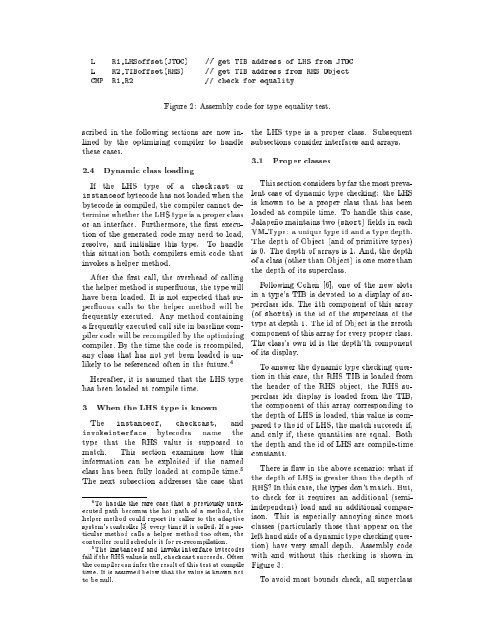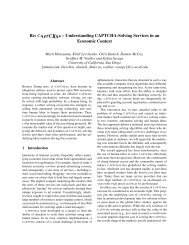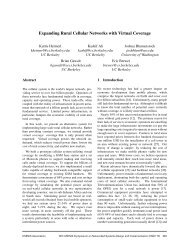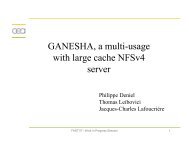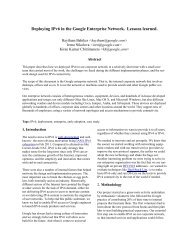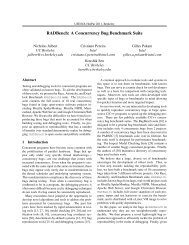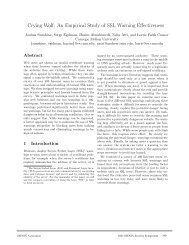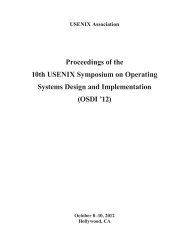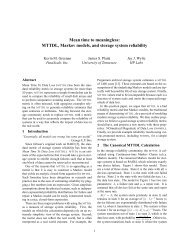Dynamic Type Checking in Jalapeño - Usenix
Dynamic Type Checking in Jalapeño - Usenix
Dynamic Type Checking in Jalapeño - Usenix
Create successful ePaper yourself
Turn your PDF publications into a flip-book with our unique Google optimized e-Paper software.
L R1,LHSoffset(JTOC) // get TIB address of LHS from JTOC<br />
L R2,TIBoffset(RHS) // get TIB address from RHS Object<br />
CMP R1,R2 // check for equality<br />
scribed <strong>in</strong> the follow<strong>in</strong>g sections are now <strong>in</strong>l<strong>in</strong>ed<br />
by the optimiz<strong>in</strong>g compiler to handle<br />
these cases.<br />
2.4 <strong>Dynamic</strong> class load<strong>in</strong>g<br />
If the LHS type of a checkcast or<br />
<strong>in</strong>stanceof bytecode has not loaded when the<br />
bytecode is compiled, the compiler cannot determ<strong>in</strong>e<br />
whether the LHS type is a proper class<br />
or an <strong>in</strong>terface. Furthermore, the rst execution<br />
of the generated code may needtoload,<br />
resolve, and <strong>in</strong>itialize this type. To handle<br />
this situation both compilers emit code that<br />
<strong>in</strong>vokes a helper method.<br />
After the rst call, the overhead of call<strong>in</strong>g<br />
the helper method is super uous, the type will<br />
have been loaded. It is not expected that super<br />
uous calls to the helper method will be<br />
frequently executed. Any method conta<strong>in</strong><strong>in</strong>g<br />
a frequently executed call site <strong>in</strong> basel<strong>in</strong>e compiler<br />
code will be recompiled by the optimiz<strong>in</strong>g<br />
compiler. By the time the code is recompiled,<br />
any class that has not yet been loaded is unlikely<br />
to be referenced often <strong>in</strong> the future. 4<br />
Hereafter, it is assumed that the LHS type<br />
has been loaded at compile time.<br />
3 When the LHS type is known<br />
The <strong>in</strong>stanceof, checkcast, and<br />
<strong>in</strong>voke<strong>in</strong>terface bytecodes name the<br />
type that the RHS value is supposed to<br />
match. This section exam<strong>in</strong>es how this<br />
<strong>in</strong>formation can be exploited if the named<br />
class has been fully loaded at compile time. 5<br />
The next subsection addresses the case that<br />
4 To handle the rare case that a previously unexecuted<br />
path becomes the hot path of a method, the<br />
helper method could report its caller to the adaptive<br />
system's controller [3] every time it is called. If a particular<br />
method calls a helper method too often, the<br />
controller could schedule it for re-recompilation.<br />
5 The <strong>in</strong>stanceof and <strong>in</strong>voke<strong>in</strong>terface bytecodes<br />
fail if the RHS value is null, checkcast succeeds. Often<br />
the compiler can <strong>in</strong>fer the result of this test at compile<br />
time. It is assumed below that the value is known not<br />
to be null.<br />
Figure 2: Assembly code for type equality test.<br />
the LHS type is a proper class. Subsequent<br />
subsections consider <strong>in</strong>terfaces and arrays.<br />
3.1 Proper classes<br />
This section considers by far the most prevalent<br />
case of dynamic type check<strong>in</strong>g: the LHS<br />
is known to be a proper class that has been<br />
loaded at compile time. To handle this case,<br />
Jalape~no ma<strong>in</strong>ta<strong>in</strong>s two (short) elds <strong>in</strong> each<br />
VM <strong>Type</strong>: a unique type id and a type depth.<br />
The depth of Object (and of primitive types)<br />
is 0. The depth of arrays is 1. And, the depth<br />
of a class (other than Object) is one more than<br />
the depth of its superclass.<br />
Follow<strong>in</strong>g Cohen [6], one of the new slots<br />
<strong>in</strong> a type's TIB is devoted to a display ofsuperclass<br />
ids. The ith component of this array<br />
(of shorts) is the id of the superclass of the<br />
type at depth i. The id of Object is the zeroth<br />
component of this array forevery proper class.<br />
The class's own id is the depth'th component<br />
of its display.<br />
To answer the dynamic type check<strong>in</strong>g question<br />
<strong>in</strong> this case, the RHS TIB is loaded from<br />
the header of the RHS object, the RHS superclass<br />
ids display is loaded from the TIB,<br />
the component of this array correspond<strong>in</strong>g to<br />
the depth of LHS is loaded, this value is compared<br />
to the id of LHS, the match succeeds if,<br />
and only if, these quantities are equal. Both<br />
the depth and the id of LHS are compile-time<br />
constants.<br />
There is aw <strong>in</strong>theabove scenario: what if<br />
the depth of LHS is greater than the depth of<br />
RHS? In this case, the types don't match. But,<br />
to check for it requires an additional (semi<strong>in</strong>dependent)<br />
load and an additional comparison.<br />
This is especially annoy<strong>in</strong>g s<strong>in</strong>ce most<br />
classes (particularly those that appear on the<br />
left hand side of a dynamic type check<strong>in</strong>g question)<br />
have very small depth. Assembly code<br />
with and without this check<strong>in</strong>g is shown <strong>in</strong><br />
Figure 3.<br />
To avoid most bounds check, all superclass


